Trumpeter Pigeon: History And Breed Guide (With Infographic)
Trumpeter Pigeon is a breed of domestic fancy pigeon. The most well-known one of this breed is English Trumpeter. Although it was initially bred and developed in the UK, it’s been trendy in the United States for selective breeding.
These are show birds and are not developed or used for flight. They got their “Trumpeter” name because of the peculiar sound they make. It is louder than other pigeons, and continuous rising and falling makes it sound like a drum.
More interestingly, they have some unique body features that make them more desirable by the pigeon fanciers. We will try to cover all the important things about this pigeon breed, especially the English Trumpeter. So, if you’re interested, keep reading.
Trumpeter Pigeon Profile
| Name | Trumpeter Pigeon (English) |
|---|---|
| Scientific Name | Columba livia (domesticated rock pigeon) |
| Common Names | Trumpeter, English Trumpeter, etc |
| Origin | England (but the modern breed is an American creation) |
| Size | Small-Medium (About 18-28 CM) |
| Weight | 300-500 g |
| Lifespan | Around 8-10 years |
| Physical Features | Curly feathers, long legs, large muffs, etc |
| Temperament | Friendly, calm, docile |
| Behavior | Active, social, vocal |
| Special Features | Trumpeting vocalization; sounds like low laughter. |
| Breeding and Maintenance | Easy to breed and care for |
| Common or Popular Varieties | English Trumpeter, Dresden Trumpeter, Brunner Pouter Trumpeter, Bokhara Trumpeter, etc. |
Looking for more articles about pigeon breed:
A Short Overview
The Trumpeter Pigeon is a small to medium-sized bird, scientifically known as Columba livia domestica. It is a fascinating and ornamental breed of domestic fancy pigeon that is a descendant of the wild rock pigeon and has many subvarieties that differ in color and markings.
This pigeon breed gained popularity worldwide for its striking appearance, gentle temperament, and unique vocalization. It is also known as one of the most ornamental birds around the world. And this breed is mainly used for the show.
History and Origins of Trumpeter Pigeon
“English Trumpeter” did not appear in literature until the 19th century, but there were mentions of Trumpeters as far back as 1582 in a German work by Horst Marks.
Recent interest in old pigeon books suggests that the Trumpeter breed may be even older than previously believed, and future scholarly research may reveal more about its origins.
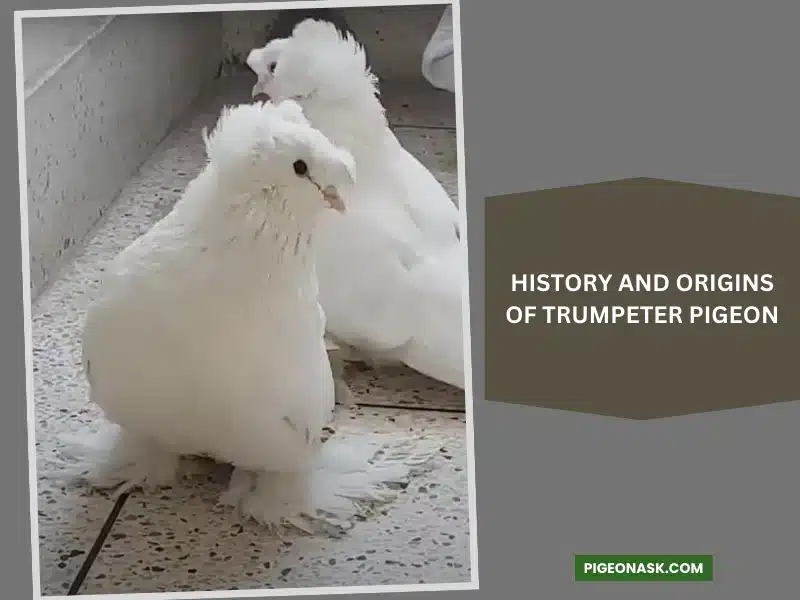
These early Trumpeters can be considered the common ancestors of the various breeds of Trumpeters seen today. The first mention of a Trumpeter in the English language is found in John Moore’s book “The Columbarium” (1735), when it was described as having a “very odd voice.”
Moore describes them as small and stout, often with black mottled plumage and feathered feet and legs. These birds have a Nun pigeon-like crown of feathers and a distinctive tuft of feathers at the base of their beak. And the name “Trumpeter” comes from their ability to mimic the sound of a trumpet.
This pigeon breed was first imported to America in the late 1800s and became popular in the early 1900s. And the breed was standardized by the American Pigeon Association in 1910. And modern Trumpeters are mostly the result of selective breeding in the USA.
Records of American pigeon hobbyists before 1870 are limited, but it is known that English Trumpeters were present in the US by that time. These pigeons likely arrived with immigrants who carried them as cherished companions on their journey to America.
Physical Characteristics and Features
Trumpeter pigeons are beautiful show birds. They have some special body features besides their unique call. Now, let’s explore why people believe Trumpeter is one of the most beautiful pigeons.
Appearance and Body Structure
The Trumpeter Pigeon has a medium-sized body with a round head, a short beak, a prominent cere, small eyes, and long legs. One of the distinctive features of this bird is its well-shaped cape-like crest which frames its face.
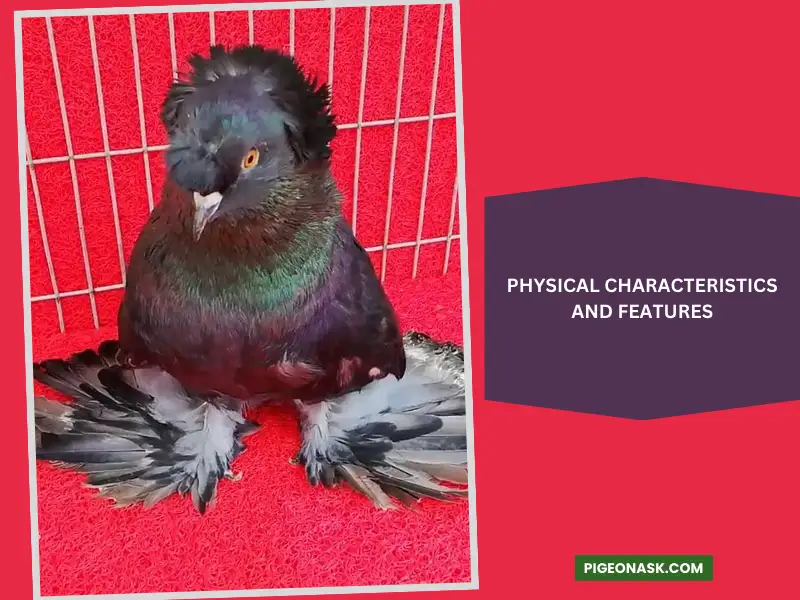
Their head is comparatively large, and their neck is somewhat short. And another unique feature of Trumpeters is their large, feathered feet, also known as “muffs.” Interestingly, their foot feathers can reach up to 5 to 6 inches in length.
In the Bokhara Trumpeter pigeon, a distinct variety of this magnificent breed, the face is concealed beneath its topknot, resembling the style of a sheepdog. And other different varieties of Trumpeters have distinctive body features and colors.
Size and Weight
As mentioned, Trumpeter is a small to medium-sized bird. On average, it can be 16-26 centimeters in length. And in some cases, this pigeon breed can reach up to 30 CM from head to tail. But most of them remain in the first range.
And about their weight, Trumpeter Pigeon weighs between 300 and 400 g on average.
Unique Features
The Trumpeter Pigeon has curly feathers on its neck, breast, back, and wings, which give it a fluffy appearance. It also has large muffs on its feet that cover its toes.
Its most distinctive feature is its trumpeting vocalization which sounds like low laughter. John Moore, in his book “The Columbarium” (1735), mentioned this call as a “very odd voice.” And some claim that it is a continuous, rising and falling, almost drum-like sound.
Common Variations in Colors and Markings Across Different Species
Different varieties of Trumpeter Pigeons may display variations in colors and markings, such as self (solid color), squash (two colors with white head), baldhead (two colors with white head and feet), almond (brownish-red with black flecks), grizzle (black with white flecks), etc.
However, the “muff” collar around their neck and the long feathered feet are almost common for this variety.
Geographical Distribution and Habitat Preference
The Trumpeter Pigeon is mainly found in North America, Europe, and Asia, where fanciers keep it as a pet or a show bird. It is not native to any region but rather a domesticated breed derived from the rock pigeon.
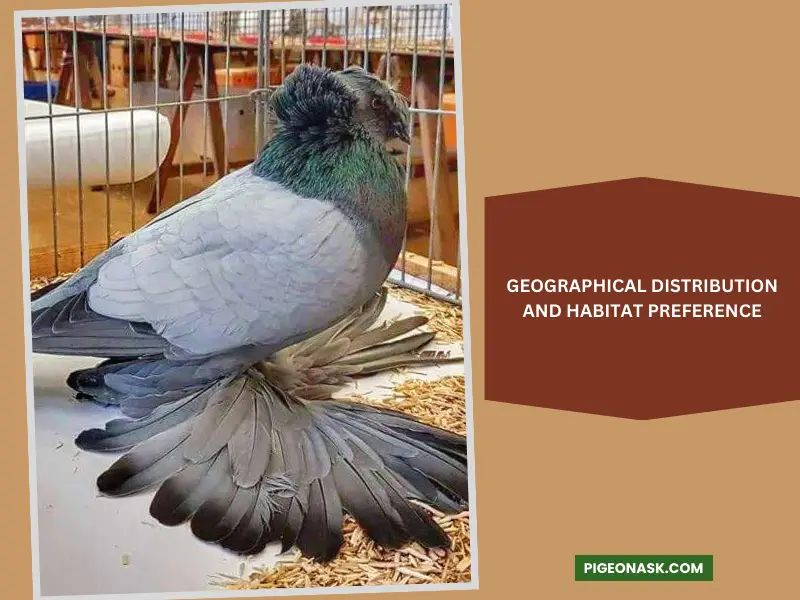
It prefers a spacious cage or loft that provides enough room for flying, perching, and nesting. It also needs fresh water and food, regular grooming and health check-ups, and protection from predators and diseases.
Trumpeter can adapt to both urban and rural habitats if it has access to adequate food and water sources, shelter, and companionship. And they do not migrate or move seasonally since this pigeon breed depends on human care and management.
Threats and Conservation Status
Well, Trumpeter is not threatened or endangered in the wild because it isn’t a natural species but a domesticated one. However, it may face some risks from predators such as hawks, cats, or dogs, diseases such as avian influenza, parasites such as lice or mites, or human factors such as neglect or abuse.
Behavior and Traits of Trumpeter Pigeon
You know that the Trumpeter is popular because of their beautiful appearance and unique call. So, do people love them only for their looks and vocals? What about their other characteristics?
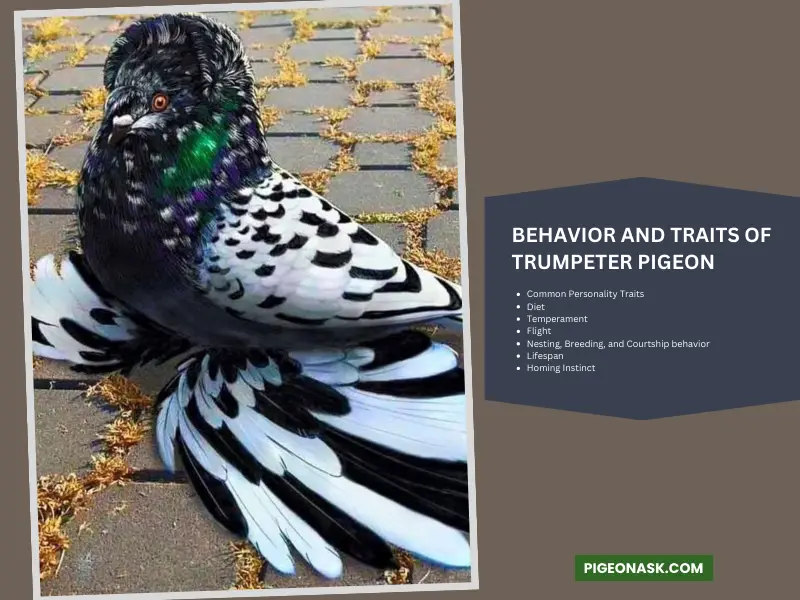
Let’s find out.
Common Personality Traits
Trumpeters are gentle and amiable in nature. They are generally friendly birds and enjoy human interaction. Sometimes, these pigeons show flock behavior, so keeping them in pairs or small groups is best to fulfill their social needs.
Trumpeters are also known to create bonds with their human owners. They are relatively quiet birds and don’t make a lot of noise. These pigeons can be trained to perform simple show tricks.
Some experts claim that Trumpeters are shy and lazy and do not fly or breed well. They are mainly appreciated for their endearing appearance and sweet personality.
Diet
Trumpeter pigeons are domesticated pigeon breeds that eat seeds, grains, corn, fresh veggies, fruits, a protein diet, and palette food available in the market. They may also eat insects since they are rock pigeon descendants.
Experts suggest that they need a variety of seeds, grains, grasses, nuts, and berries to stay healthy.
From our research and observations, here are some additional tips for feeding Trumpeter pigeons:
Temperament
As I mentioned before, Trumpeter pigeons are popular for their good behavior, gentle nature, attractive appearance, and their vocalization. They are usually shy and sweet and don’t fight with other birds.
Trumpeters are known for their easygoing disposition, making them relatively easy to handle and keep as pets. And due to their calm demeanor, they are suitable for keeping as ornamental birds and for exhibition purposes.
Flight
These pigeons are not known for their flying abilities. In fact, the English Trumpeter has very large muffs on its feet (most of them have), which often grow to sizes close to its flight feathers. This makes them heavy and clumsy in flight.
They can fly but are not very agile or fast. Other types of Trumpeter pigeons may have better flying skills, but they are not popular among racing pigeon fanciers.
Nesting, Breeding, and Courtship behavior
From our research and findings, we couldn’t verify any authentic source of information regarding Trumpeter’s nesting, breeding, and courtship behavior. But with the discussion of some experts, we get a general idea about them. Which are –
These pigeons are monogamous and form long-term bonds with their mates. Like other pigeons, Trumpeters may engage in courtship displays such as circling, bill-touching, chasing, and feeding. The female lays one or two eggs per clutch, usually twice a year, depending on the weather condition and environment.
The eggs take around 16 to 18 days to hatch. And both parents take turns in incubating and feeding the young.
Lifespan
The exact lifespan of the English Trumpeter pigeon breed is not known. However, another Trumpeter pigeon breed (the Bokhara Trumpeter pigeon) has a lifespan of between five and seven years.
Hence, the lifespan of the Trumpeter pigeons can be considered to be similar or close. Other types of Trumpeter pigeons may have different lifespans depending on their health, diet, and environment.
Homing Instinct
Trumpeter pigeons are not bred for their homing abilities, so they may not have a strong homing instinct compared to other types of pigeons. However, since they are descendants of the wild rock dove, they may still have some capacity to find their way home over long distances.
Scientists believe that pigeons use their sense of smell to navigate by detecting infrasounds (low-frequency sounds) that are produced by nature, such as the ocean, mountains, and wind. Other factors that can influence pigeons’ homing instinct are magnetic fields, sunlight, landmarks, and genetics.
Breeding and Maintenance of Trumpeters
Breeding Trumpeter pigeons is not easy. They are lazy birds who don’t wish to move, fly, or breed. This breed mates like other pigeons and lays 2-3 white eggs. If you plan to breed Trumpeters, you must have some prior experience. Also, be ready to take care of their babies.
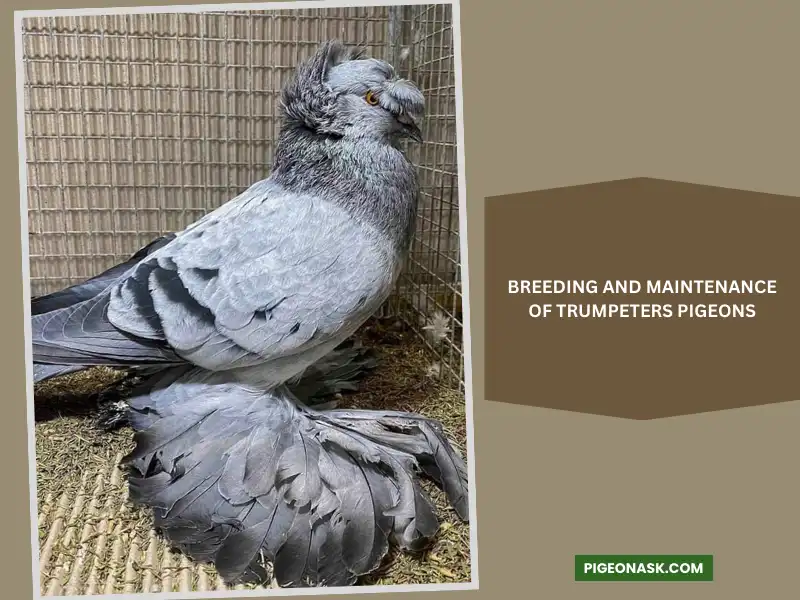
However, you can follow some basic guidelines for this, such as choosing a healthy pair for the breeding. The pair must be one year old or more mature. Trumpeters have different colors and body structures. So, select the one according to your need. Let them mate naturally, don’t try to force the process.
After mating, the female will lay one or two white eggs. Both parents usually take part in the incubation. Here, you should provide a safe and clean environment. Normally, it should take 17 to 18 days to hatch.
When the hatchling comes, the pair will take care of it. But remember that different types of Trumpeter pigeons, such as the English Trumpeter and the Bokhara Trumpeter, may have different characteristics and requirements.
Tips for Successful Breeding
Here are some tips that can help you to have a successful Trumpeter breeding experience:
- Breeding season for Trumpeter pigeons typically begins in the spring, but it can vary depending on the climate. So, focus on this time.
- The selected pigeons shouldn’t be less than a year. It may compromise the percentage of successful breeding.
- Provide a quiet, peaceful, and safe environment for the process.
- The hatchlings need to be cared for around 30 days.
Feeding and Housing Requirements for Trumpeter Pigeons
To successfully breed Trumpeter pigeons, you need to provide them with a good diet and comfortable housing. For their diet, as mentioned, you can feed them a mix of poultry pellets, seeds, grains, corn, fresh veggies, fruits, and palette food available in the market.
You can also give them some grit and calcium supplements to help them digest their food and produce strong eggs.
For their housing, provide them with a spacious aviary or a large cage that has enough room for them to move around and exercise.
Also, give them clean water, nesting boxes, perches, toys, and bedding material. And don’t forget to keep their house clean, dry, and ventilated with no chance of predators and diseases.
Related Subvarieties of Trumpeter Pigeon
As you already know, there are several known subvarieties of this pigeon. And each has some unique characteristics and identical features. Let’s take a look at some of the most popular ones.
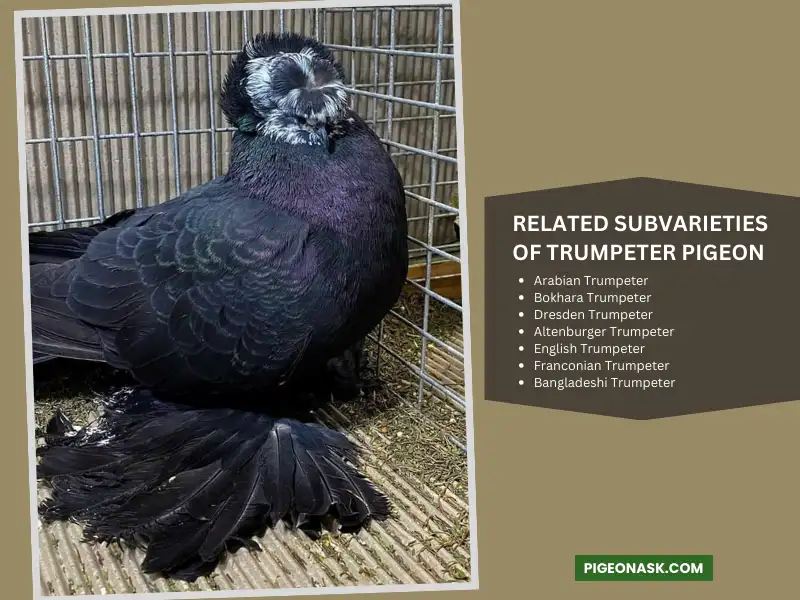
Arabian Trumpeter
It is an old racial pigeon from Asia, especially from Saudi Arabia. It is rumored that this variety is still a direct descendant of the rock pigeon (Columba livia), which is a pure Arab race.
The Arabian Trumpeter is a medium-sized bird with a short beak, a slightly larger head, a small crest on the top, a neck that is comparatively long, and well-feathered legs. It comes in various colors, such as black, red, yellow, blue, and white.
Bokhara Trumpeter
The Bokhara Trumpeter is from Central Asia, especially from Bukhara, Uzbekistan. It has long-muffed (feathered) feet and a double crest. This pigeon can be black, blue checkered, white, red, or yellow. It is a gentle and calm breed, but some fanciers may find it lazy. And it is popular for its unique voice.
Dresden Trumpeter
This fancy pigeon is bred for both voice and exhibition purposes and originates from Saxony in the region of Dresden in Germany. It is also a descendant of the rock pigeon.
The Dresden Trumpeter is characterized by its medium-sized body, short beak, and large head with a small crest. This pigeon also has a long neck and feathered legs.
You can find them in different colors, such as black, red, yellow, blue, and white. And they are usually friendly and active breeds but may require some extra care.
Altenburger Trumpeter
The Altenburger Trumpeter is native to the picturesque Thuringian region of Altenburg in Germany. Its body is slender-shaped, has a long beak on a small head, the crest is comparatively large, the neck is somewhat short, and unlike other Trumpeters, it doesn’t have feathers on its legs.
This breed can be in black, red, yellow, blue, and white colors. It is usually a lively bird, but you may provide some training for voice development.
English Trumpeter
Now, the English Trumpeter Pigeon is a breed of domestic fancy pigeon that originated in England but was later developed in the United States through selective breeding.
It is renowned for its ornamental beauty, characterized by a cape-like crest thrown back on its head, large muffs covering its feet, and a tuft and crest on its head.
Franconian Trumpeter
This is another variety of Trumpeter pigeons that originated from Oberfranken, Germany, around 1900. It has a short, stout neck, rich feathered crest, and clean legs. It is also known by other names such as Tambour de Franconie, Fränkische Trommeltaube, and Tamburo in Franconia.
Bangladeshi Trumpeter
The Bangladeshi Trumpeter is a local breed of fancy pigeon from Bangladesh. It is also known as Bashiraj Kokha and is valued for its sharp voice and smaller body shape. It has become very rare in this country because of various types of fancy pigeon breeds.
Final Thoughts
Well, Trumpeter pigeons are the descendant of the rock pigeon. This is a fancy breed that is renowned for its appearance and distinctive vocal. They create a high and low drum-like sound, and this is where they get the name.
There are different varieties of Trumpeters available around the world. But all of them are domesticated breeds and mostly valued for look and voice. You can breed them too. But it requires experience and a proper environment. However, you can always take advice from the experts on the matter.
Image Credits:
- https://www.pigeontype.info/2018/01/24/english-trumpeter-pigeons/
- https://www.youtube.com/(@fancypet1608)
- https://www.facebook.com/Pigeonsintheworld
- https://www.facebook.com/ Pigeon World
- https://www.facebook.com/ people/Pigeon-Lovers
